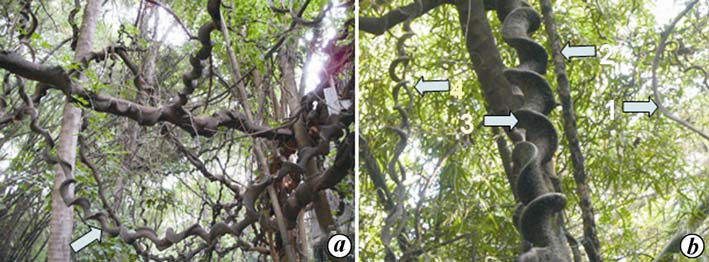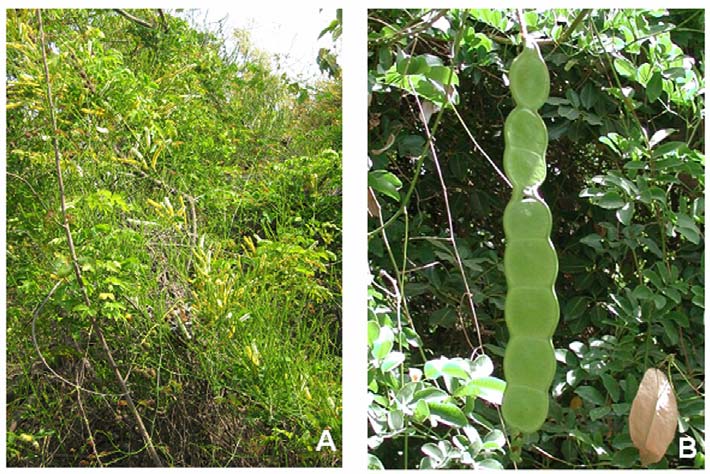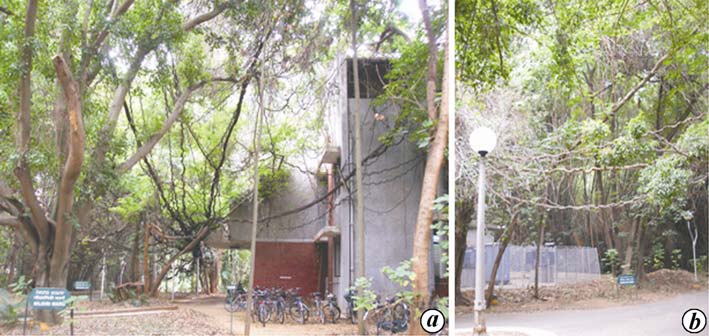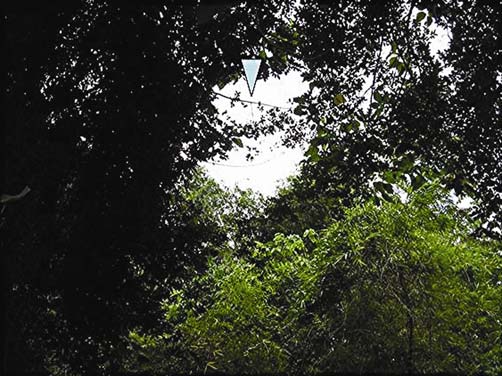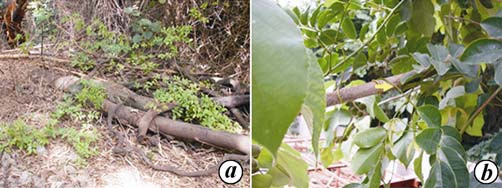|
Home
Introduction Materials and methods Results and discussion Conclusions Acknowledgement References |
|
Results and Discussion The superstructure of Entada is comprised of a mix of structures of a tree and a woody climber, and some unique structures. Its erect trunk is comprised of anticlockwise-twisted pleats. Its climber part comprises of hammock-like twisted, woody stems. The structure that has spread its canopy from one support tree to another is long, leafless cable-like stem (stolon) that navigated aerially approximately 15 meters above the ground, differentiating foliage upon accessing a living tree. Freestanding trunk The Entada trunk has a girth of 2.1 meter at the base and 1.7 meter at breast height and is organized as helically twisted pleats (Fig 1A). Although we missed out the ontogenetic changes, the self-supporting trunk may have resulted from orthotropic vegetative offshoots that developed from the base of the sapling. This is plausible as according to the noted researcher of rainforests, P. W. Richards5, “tropical rain-forests trees often produce coppice-shoots very readily when the main trunk has fallen or decayed …a new formation of coppice-shoots grows up round the secondary main trunk”. We assume that in its juvenile phase Entada formed circumnutating offshoots from the base, allowing mutual contacts and eventually fusing to form a mechanically-independent trunk. Circumnutation is a common property in climbers that enables contacting a potential support in the vicinity6-8. Sectioning of this solitary specimen for wood anatomy was not possible. However, a reason for considering the Entada trunk as comprised of basally- formed conjoined offshoots is because the pleats unwind at 1.5 to 3 meter above the ground and diverge as branches either in vertical or in horizontal directions. No other liana is known with a trunk constructed similarly, although the Neotropical liana Croton nuntians (Euphorbiaceae) in French Guyana is free standing and resembles a young tree but becomes unstable and leans on surrounding vegetation for support9. Anticlockwise twists in climbing parts The uncoiled trunk pleats have branched out into hammock-like, highly twisted woody branches (Fig. 1B). Yet, no above-ground part has twined around a support tree or its branches; hence Entada is not a twiner. Rather, its branches mostly lie on the host branches for support and occasionally entangle into them. A striking feature of Entada is the portions of climbing branches shaped into an ‘Archimedes screw’ (Fig. 2) with pronounced tangential thickening. The significance of this patterning is unknown. Recently, a theory has been put forward for formation of twists in stems subjected to bending stress10. We have not observed any thorns, hooks, spines or stem tendrils that could facilitate Entada’s anchoring to the supporting tree. Rather, physical support is gained by occasional placing of its branches on those of support trees. At best, Entada may be classified as a straggler.
Some of its overhanging leafy branches that were exposed to full sunlight during March-April (before monsoon rains begin) produced inflorescence (Fig. 3). Invasion and spreading strategy Thus far, all previously reported lianas spread their canopy by means of ground stolons which then climb on available support. Entada is unique: it has formed specialized, cable-like, aerial stolons (Figure 4) that have extended near-horizontally into air, crossing gaps and spreading canopy from the primary support tree onto the crowns of other support trees (Figure 5). The length of these aerial stolons exceeds 15 m; and there is no evidence of a support tree being present between the inter-support distances, because of a dividing tarred road. Hence investigations are required as to how Entada sensed the availability of support trees across tree gaps, the time and rate of elongation of stolons and the chemical cues directing their aerial trajectory towards the available crown. Indeed, it was the aerial stolons traversing a road junction over a lamp post which attracted the attention of two authors to an unusual plant type growing in the campus. Following contact with the crown of support trees, the stolons have branched and much of their twisted woody branches appear to support each other (self-support), with this being augmented by the branches that have infiltrated into the trees. A stand of bamboo culms accessed across a gap due to a road is bent down to a greater degree than the uninfested culms, either because of the weight of Entada or because Entada exerted a force to pull them down. Structural adjustments that are required to counter stress and strain as a consequence of tension due to pull need investigation.
Since the aerial stolons are oriented towards a vegetated tract across a tarred road without crisscrossing (Figure 4), a possibility is that other than phototropism, some volatile chemicals produced by the ‘host’ trees not only provided a cue for the development of cables, but also directed their extension towards trellises. This speculation is supported by a recent finding that volatile compounds, a-pinene, ß-myrcene, 2-carene, p-cymene, ß-phellandrene, limonene, (E,E)-4,8,12-trimethyl-1,3,7,11-tridecatetraene and an unidentified monoterpene released by tomato plant guide the dodder vine, Cuscuta pentagona14. Rowe and Speck15 have illustrated ‘searcher branches’ in a woody liana Strychnos sp. (Loganiaceae), having a cable-like appearance and extending horizontally 3–4 m across the canopy gap to locate new support. Upon contact with a neighbouring tree, the Entada cables (stolons) differentiated normal foliage, viz. compound leaves with thick leaflets. The branches of Entada have infiltrated and entangled with that of Bauhinia purpurea, Cassia spectabilis, Broussonetia papyrifera, Tebebuia rosea, Eucalyptus tereticornis, Tectona grandis and Bambusa sp. However, we have not observed Entada on dead branches of standing trees, raising the possibility of requirement of living support trees for infestation. Since coiling, bending or flexing and differentiating into morphologically distinct parts occur in response to contact, the phenomenon of thigmomorphogenesis appears to be important in the infiltration and spread of Entada on living trees. We have not observed new cables (aerial stolons) being formed in the four years since regular observation of Entada, suggesting that there could be periodicity of years in triggering its development. Some bamboos behave similarly16. A contentious explanation is that the aerial stolons were formed in response to some unusual weather trigger. Perhaps, more likely is periodicity in their development. Possibly these were stiff as the culms of bamboo, and extended rapidly across tree gaps. Based on an estimate of its spread size and the timescale, it appears that Entada could be amongst the fastest growing plants; rivalling the bamboos in which the culms grow almost 4 ft in a 24 h period . The fast growth rate of stolons against gravity will enable them to take mechanical risk17. Cable-like stolon along the ground surface with ascending apex was illustrated in a palm Desmoncus orthacanthus, growing in the rainforests in South America18 and in rhizomatous shrub Xanthorhiza simplicissima, growing in the Botanical Garden in Freiburg, Germany19. However, data on its rate of extension was not given. Penalosa7 reported a liana Ipomoea phillomega in the rainforest of Mexico, with leafless, creeping stems (stolons) on the ground that extend up to 30 m at a mean rate of 13.6 cm/day, and turning upwards in a S-shaped manner upon contact with a potential support and twining around a support host in sunny clearings. The climber Clematis maritima changes its morphology when growing on aboveground areas and on sand17. We have not observed surface- growing stems in adult Entada. Its aerial stolons changed morphology upon accessing a support tree, suggesting that in addition to light and circumnavigational movement, contact-induced differentiation of foliage is important in mechanistic explanation of Entada spread on crowns of support trees as a straggler. Trellis availability is a major factor determining the success of canopy-bound lianas20. Hydraulic supply The parent and the interconnected daughter canopies of Entada are founded on a single germinated seed and hence on a single root system. Since the aerial stolons ultimately connect to the rooted trunk, these must constitute the hydraulic system for the entire canopy. When aerial stolons (cables) extending across a road junction, posing hazard to motorists were cut, colourless, watery sap trickled from the cut cables. This suggests that water is translocated by root pressure, requiring development of non-destructive methods for investigation of its underground parts. Apparently, the twists in plant structure do not resist the movement of water, making Entada a good material for investigations of pressure-generating capability for water movement, compared to a tree. Following severing, the daughter canopies differentiated by aerial stolons and distributed on surrounding trees dried, confirming that the aerial cables constitute the hydraulic supply system and the structural form for the spread of the canopy on support trees. Ecophysiology Occasionally, a terminal leaflet in the pinnate compound leaves of Entada is modified into a forked tendril (Figure 6 b). Tendril development may be influenced by the amount of light filtering through the canopy, and its function may only be to orient the leaf for maximal absorption of sunlight by the canopy in natural habitat under cloudy conditions. A visual comparison of the density of Entada foliage with that of the surrounding trees suggests that this liana invests more of photosynthetically fixed carbon in woody branches, which have a capacity to resprout after breakage. The first sighting of a single 12 inches long, green pod was in May 2003, and again in 2005 and 2008. It therefore appears that fruiting in the alien environment is a rare phenomenon, for unknown reasons. Although being a leguminous plant, Entada is assumed to be selfpollinated, the lack of a pollinator species could account for its rare fruiting. Further observations are required to determine if flowering and fruiting in the daughter canopies is synchronized with that of the interconnected parent canopy. Brandis2 described fruits of E. pursaetha as 2–4 ft long and 3–4 inches broad. An Entada pod in the Phansad Wildlife Sanctuary (about 152 km from Mumbai) was found to be nearly 6 ft long. Entada pods are therefore among the largest legumes. The ability to produce large pods with rather large seeds2,3 suggests a high photosynthetic rate. It is believed that lianas have a fast growth rate because of their high photosynthetic rate due to elevated CO2 in the canopy21. Contrary to popular belief, liana density and growth are unrelated to the mean annual precipitation19,21,22. Schnitzer22 reported that lianas grow nearly twice as much as trees during the wet season, but more than seven times that of trees during the dry season. This observation was corroborated by Swaine and Grace23. In view of the requirement of seedling material for experimental investigations in the laboratory, the reproductive biology of Entada assumes special importance. Regeneration Aerial stolons (diameter approximately <10 cm) that had begun to cause obstruction to vehicular traffic were cut. Two to four metre long cut pieces of woody stems (diameter 20–30 cm) were gathered and left in the open. In about 4 weeks the cut stems sprouted one to 1½ m tall shoots with stiff, erect stems producing foliage (Figure 6). Since sprouting occurred during the dry season, this observation signifies that Entada stores considerable water inside the stem tissue. However, the cut stems did not root, and the sprouts dried after the rains ceased. However, the ability of cut stems to resprout has implication in its natural habitat where strong wind and rain prevail: The branches that are unable to resist wind-induced breakage or those that are unstable under their own weight may fall on the ground and function as ramets (vegetatively produced, independent plants). This raises the question of the specific contribution of the ramets (broken and fallen branches that resprout and form roots) versus the genets (single individual plants from sexually formed seeds) in the composition of Entada thickets in its natural habitat. In Panama, Putz20 noted the propensity for lianas to sprout vigorously from fallen stems. Based on seedling excavations, Putz found that 90% liana species in the understorey were ramets.
Paradox of growth in alien environment The factors that may explain an alien liana thriving in a place which receives only about 95 cm annual rainfall and where the soil surface (red earth) is generally dry, except for the monsoon months (May–September) are: (1) Foremost, a safe mode of infiltration on available support trees by means of aerially formed stolons, thereby avoiding risk of injury from trampling by grazing animals. (2) Nutrient-rich soil in the campus (the soils in rainforests is generally nutrient-poor because of the leaching of nutrients by rains through the millennia5,24). (3) Presumed deep root system of Entada allowing access to water table, or water which seeped down from a nearby stream. This is in keeping with a report25 that root systems in excavated liana seedlings of Davilla kunthii (Dilleniaceae) in eastern Amazonia were more than eight times longer than the aboveground stem. (4) Higher solar illumination26. (5) Absence of herbivores or pathogens and less competition for resources as more area is available for aerial spread, root growth and nutrient absorption, unlike in dense vegetated tropical forests. Finally, what explains the distribution of Entada in coastal sea areas and river banks? Water may play a key role for dispersal as well as for breaking of dormancy of big, heavy Entada seeds. The presence of aquatic microorganisms and the lytic enzymes leached from them would soften the testa. Despite the extensive spread of Entada genet in an alien environment, we are hesitant in attributing this as ‘success’, since ecologically ‘success’ is a measure of reproductive efficiency, namely the number of individual genets or ramets per unit area and density of liana growth26. Success of introduced Entada can only be assessed if it becomes naturalized by production of new genets or ramets. |
| E-mail | Sahyadri | ENVIS | Energy | GRASS | CES | IISc | E-mail |
